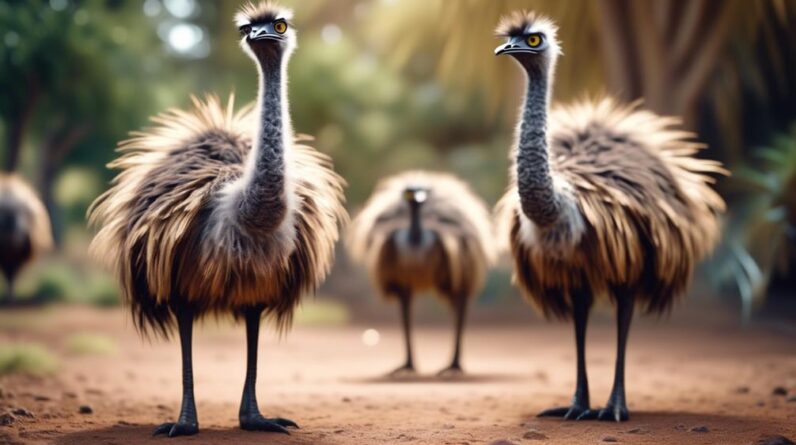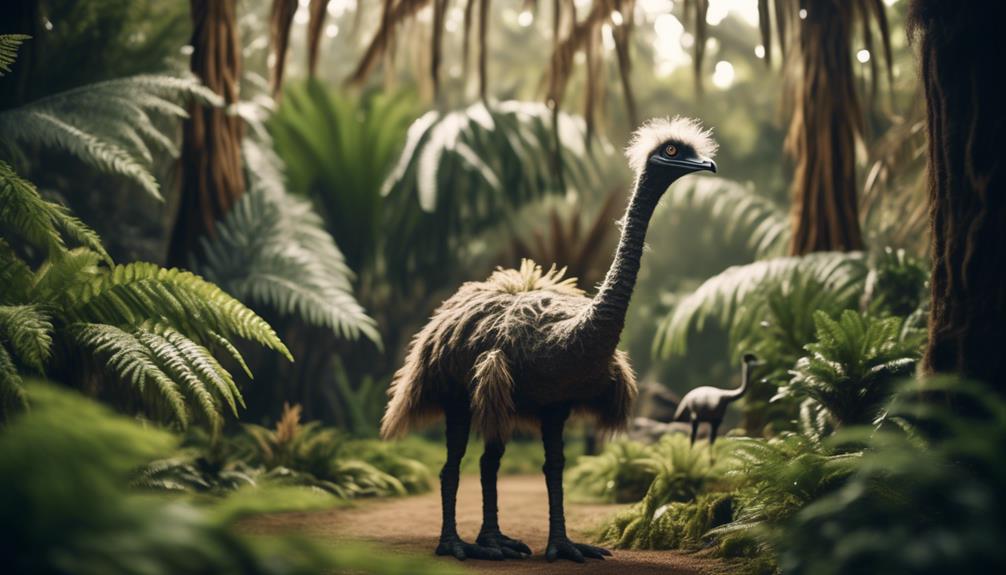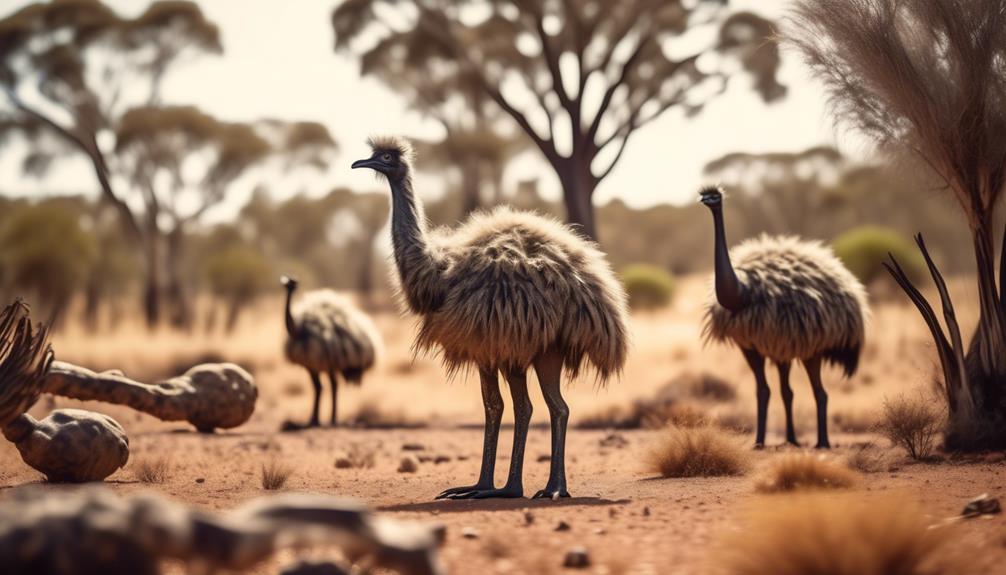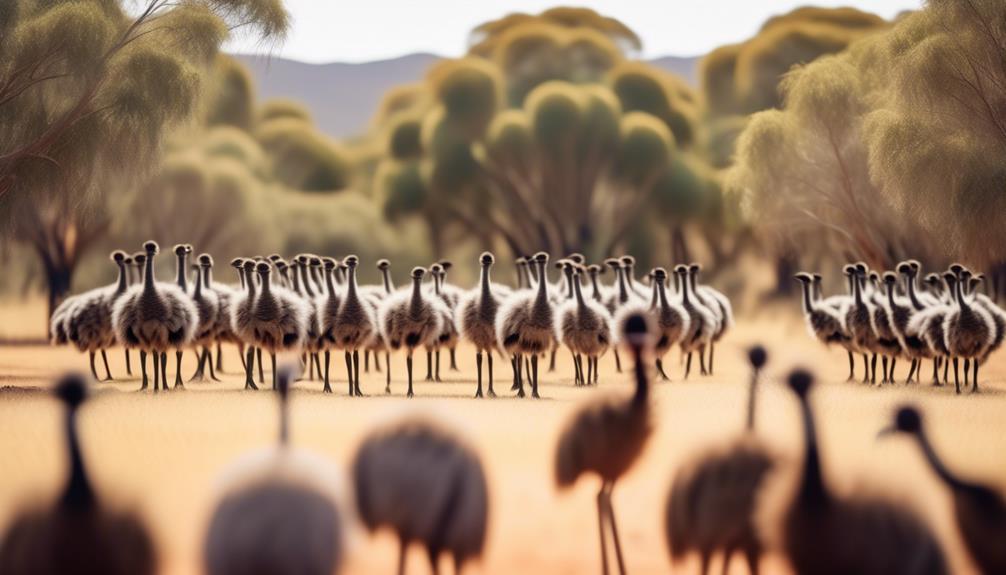
You may think that emus, with their comical appearance and inability to fly, are just another quirky bird species. However, the evolution of emus is a fascinating journey through time that will leave you amazed at their resilience and adaptability.
From their ancient origins to their unique evolutionary path in Australia, emus have defied the odds and survived through mass extinctions and changing climates. But what is their relationship with humans, and what efforts are being made to conserve these remarkable creatures?
Join us on this captivating exploration of the evolution of emus, and prepare to be intrigued by their remarkable story.
Key Takeaways
- Emus evolved from flying ancestors and gradually lost their ability to fly, adapting to a terrestrial lifestyle.
- Different populations of emus developed distinct physical traits and behaviors based on their habitat.
- Emus have a unique reproductive strategy with males incubating the eggs.
- Climate change and human activities pose significant threats to emu populations and their habitats.
The Ancient Origins of Emus
The ancient origins of emus can be traced back to the supercontinent Gondwana, where they evolved alongside other flightless birds millions of years ago. Emus have a rich evolutionary timeline that spans over millions of years, with their ancestors dating back to the early Cenozoic era. Fossil evidence suggests that emus' ancestors were once capable of flight, but as their environment changed, they gradually lost their ability to fly and adapted to a terrestrial lifestyle.
Emus hold a significant place in folklore and cultural traditions of various indigenous Australian tribes. These majestic birds are often depicted in creation stories and are revered for their unique characteristics. In some Aboriginal legends, emus are believed to have played a role in the creation of the world, symbolizing fertility and rebirth.
Emus' evolutionary journey has been shaped by environmental factors and natural selection. Their large size, powerful legs, and unique feeding habits have allowed them to thrive in the harsh Australian outback. Today, emus are the largest birds in Australia, renowned for their speed, agility, and distinctive appearance.
Understanding the ancient origins of emus provides valuable insights into their adaptation and survival strategies. These fascinating creatures not only have a place in scientific studies but also hold a special significance in the cultural heritage of the Australian people.
Early Adaptations and Diversification
As emus continued to evolve and adapt, their early adaptations and diversification played a crucial role in shaping their survival strategies and unique characteristics. These early adaptations allowed them to thrive in various environments and exploit different food sources. One key adaptation was their ability to run at high speeds, which enabled them to escape from predators and cover large distances in search of food and water. Their long legs, strong muscles, and unique joint structure provided the necessary agility and endurance for these impressive sprints.
Diversification also played a significant role in shaping emu evolution. Over time, different populations of emus developed distinct physical traits and behaviors that suited their specific habitats. For instance, emus in arid regions developed adaptations to conserve water, such as a reduced urine production and the ability to lower their body temperature. On the other hand, emus in more temperate regions developed adaptations to withstand colder temperatures, such as a thicker plumage and increased fat reserves.
Furthermore, emus underwent diversification in terms of their diet. While their ancestors were primarily herbivorous, early emus started incorporating insects and small vertebrates into their diet. This dietary diversification allowed them to exploit a wider range of food resources and adapt to changing environmental conditions.
Emus in the Age of Dinosaurs

During the Age of Dinosaurs, emus coexisted with large, terrestrial reptiles and adapted to thrive in a world dominated by these ancient creatures. Emus and other dinosaurs inhabited prehistoric environments, characterized by lush forests, vast plains, and meandering rivers. Emus, much like their modern counterparts, were well-suited to their surroundings, displaying remarkable adaptability and resilience.
In this primeval landscape, emus roamed alongside colossal herbivorous dinosaurs, such as the long-necked sauropods, and formidable carnivorous predators, like the fearsome Tyrannosaurus rex. The emus' slender, agile bodies allowed them to navigate through dense vegetation, while their strong legs and sturdy feet enabled them to flee from potential threats. Their beak, a distinguishing feature, evolved to efficiently forage for vegetation and small insects, providing them with a diverse diet.
Emus in prehistoric environments faced unique challenges. They'd to contend with the constant presence of predators, including not only dinosaurs but also reptiles such as crocodiles. To avoid becoming prey, emus developed a keen sense of awareness and heightened speed, allowing them to outrun their pursuers. Additionally, they honed their ability to blend into their surroundings, utilizing their camouflage to evade detection.
The emus of the Age of Dinosaurs were remarkable creatures, skillfully adapting to a world filled with towering reptiles. Their ability to survive and thrive in such an environment laid the foundation for the evolution and success of emus that we see today.
The Flightless Ancestors of Emus
Emus' flightless ancestors, existing in prehistoric times, possessed unique characteristics that contributed to their evolutionary path. These flightless bird species, similar to their modern-day descendants, were known for their large size, strong legs, and reduced wings. These evolutionary adaptations allowed them to navigate the terrestrial environment with ease, while sacrificing their ability to fly.
One notable characteristic of these flightless ancestors was their robust skeletal structure. Their sturdy, weight-bearing legs enabled them to support their large bodies and traverse long distances on foot. Additionally, their wings became smaller and more rudimentary over time, as they were no longer necessary for aerial locomotion.
Another important adaptation of these flightless ancestors was their reduced keel bone. The keel bone, which serves as an anchor for flight muscles in birds capable of flight, became smaller and less prominent in these flightless species. This reduction in keel size was a direct response to the lack of flight, as these ancestors no longer needed the same level of muscle attachment for sustained flight.
These evolutionary adaptations of the flightless ancestors of emus allowed them to thrive in their terrestrial environment. Although they lost the ability to fly, they gained advantages in ground-based locomotion and survival strategies.
These adaptations paved the way for the emus we see today, demonstrating the remarkable journey of evolution in these remarkable flightless birds.
Emus and the Changing Climate

The changing climate has had significant implications for the evolutionary trajectory and survival strategies of emus. As climate change continues to alter the Earth's ecosystems, emus are facing unprecedented challenges.
One of the most notable impacts is the loss of suitable habitats for these flightless birds. Emus have adapted to live in a variety of environments, from savannas to forests, but their survival depends on specific conditions. With climate change, these conditions are rapidly changing, leading to habitat loss for emus.
Rising temperatures and changing rainfall patterns directly affect the availability of food and water sources for emus. As their habitats become drier and more arid, the vegetation that emus rely on for sustenance diminishes. This scarcity of resources forces emus to adapt their foraging behavior or migrate to more favorable areas, which may not always be possible. Additionally, extreme weather events, such as droughts and storms, further exacerbate the challenges that emus face in finding suitable habitats.
The loss of habitat due to climate change also increases the likelihood of conflicts between emus and humans. As emus search for new territories, they may encroach upon human settlements, leading to increased interactions and potential conflicts. This highlights the need for effective conservation strategies that take into account both the needs of emus and the communities they come into contact with.
Emus: Survivors of Mass Extinctions
Emus, remarkable survivors of past mass extinctions, have withstood the test of time and adapted to changing environments. These flightless birds, native to Australia, have played a crucial ecological role throughout history. Here are three fascinating facts about the emus' resilience and their importance in conservation efforts:
- Ecological Role: Emus have a significant impact on the ecosystems they inhabit. As herbivores, they contribute to seed dispersal by consuming fruits and excreting the seeds elsewhere. This process aids in the regeneration and diversification of plant species. Additionally, their foraging behavior helps control vegetation, preventing the dominance of certain plant species and promoting biodiversity.
- Conservation Efforts: Emu conservation has become increasingly important due to habitat loss, climate change, and human activities. Efforts are underway to protect their natural habitats, establish protected areas, and mitigate threats from predators and invasive species. Conservation organizations are also working to raise awareness about the importance of preserving emu populations and their ecological role.
- Future Challenges: Despite their resilience, emus face challenges in the modern world. Climate change and habitat loss continue to impact their populations. It's crucial to implement sustainable land management practices, protect their habitats, and support conservation initiatives to ensure the survival of these incredible birds for generations to come.
Emus, as survivors of mass extinctions, remind us of the fragility and resilience of life on our planet. By understanding their ecological role and supporting conservation efforts, we can contribute to the preservation of these fascinating creatures and the ecosystems they call home.
Emus in Australia: A Unique Evolutionary Path

What makes the evolutionary path of emus in Australia unique?
The emu, Dromaius novaehollandiae, has undergone remarkable evolutionary adaptations to thrive in its unique habitat. Emus are flightless birds that have evolved in isolation on the Australian continent for millions of years. They inhabit a diverse range of environments, from coastal regions to arid deserts, and have adapted to survive in these harsh and unpredictable conditions.
One of the key evolutionary adaptations of emus is their powerful legs, which enable them to run at high speeds of up to 50 kilometers per hour. This adaptation allows them to escape from predators and cover long distances in search of food and water. Emus also have large, muscular bodies and strong beaks, which they use to forage for a variety of plant materials and insects.
Emus have also developed a unique reproductive strategy. During the breeding season, male emus construct a nest on the ground and incubate the eggs, while the females move on to find another mate. This behavior is unusual among birds and reflects the challenging environment in which emus live.
Emus and Their Relationship With Humans
Emus have had a long and complex relationship with humans throughout history. These fascinating creatures have captivated our attention and woven themselves into our lives in various ways.
Here are three intriguing aspects of the relationship between emus and humans:
- Emus as pets: Over the years, emus have been domesticated and kept as pets by some individuals. Their unique appearance and playful nature make them a popular choice for those seeking non-traditional companions. However, it's important to note that emus require specific care and a suitable environment to thrive in captivity.
- Emus in folklore and mythology: Emus hold a significant place in the folklore and mythology of many cultures. In Australian Aboriginal Dreamtime stories, emus are often portrayed as wise and cunning creatures, associated with creation and survival. In other cultures, emus symbolize strength, endurance, and adaptability.
- Economic significance: Emus have also played a role in the economic activities of humans. In the past, emu feathers were highly valued for decorative purposes, and their oil was used in various industries. Today, emus are bred for their meat, which is lean and nutritious, offering an alternative to traditional poultry.
The relationship between emus and humans is a testament to the diverse ways in which we interact with and appreciate the natural world. From pets to mythical beings and economic contributors, emus continue to fascinate and enrich our lives in countless ways.
Conservation Efforts for Emus

Efforts to conserve and protect emus have been implemented to ensure the long-term survival of this unique species. Emus in captivity play a crucial role in these conservation efforts. Many zoos and wildlife sanctuaries around the world house emus to not only provide them with a safe environment, but also to educate the public about their importance and raise awareness about their conservation needs. These captive emus are often part of well-managed breeding programs, which aim to increase their population size and genetic diversity.
Emu breeding programs focus on maintaining a healthy and genetically robust population. Expert caretakers closely monitor the emus, ensuring their well-being and success in reproduction. By carefully tracking the lineage and genetic information of each emu, breeders can make informed decisions about which individuals should mate to maximize genetic diversity and minimize the risk of inbreeding. This careful selection and management of emu breeding pairs help maintain healthy populations and reduce the risk of genetic disorders.
Furthermore, these breeding programs are also essential for reintroducing emus into their natural habitats. Once the emus have been successfully bred in captivity, they can be released into suitable areas where their populations have declined. This reintroduction process is carefully planned and monitored to ensure the emus' successful adaptation to their natural environment.
Frequently Asked Questions
How Do Emus Mate and Reproduce?
Emus have a unique reproductive process. They mate through copulation, with the male mounting the female. The female then lays large eggs in a communal nest, which the male incubates. Emus are known for their fascinating breeding habits.
What Is the Average Lifespan of an Emu in the Wild?
On average, an emu in the wild has a lifespan of around 10 to 20 years. During this time, they migrate across different habitats, adapting their diet and foraging habits to survive in various environments.
Are Emus Social Animals or Do They Prefer to Live Alone?
Emus, fascinating creatures, exhibit complex social behavior. They are not solitary beings, but rather form social groups. Social interactions play a crucial role in their survival strategies, enabling them to adapt to the impact of climate change.
How Do Emus Defend Themselves Against Predators?
When it comes to defending themselves against predators, emus have unique defensive behaviors. They use their long legs to kick with incredible force, and their sharp beaks can inflict serious damage.
What Is the Current Population Status of Emus in Australia?
Emus in Australia face conservation efforts due to threats to their population. Efforts are being made to protect their habitats and manage predator populations. The current population status of emus is closely monitored to ensure their survival.
Conclusion
Congratulations! You have embarked on a fascinating journey through the evolution of emus. From their ancient origins to their unique adaptations, emus have withstood the test of time and changing climates. These flightless birds have proven to be survivors, even in the face of mass extinctions.
Their evolutionary path in Australia is truly remarkable. As humans, we have a responsibility to ensure the conservation of these incredible creatures.
So, let's spread our wings and protect the emus, for they truly are the cream of the crop in the avian world.





